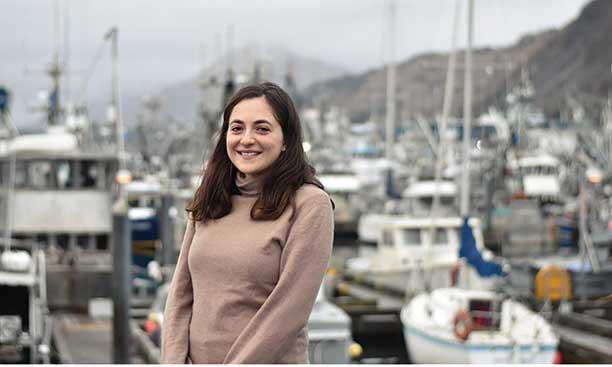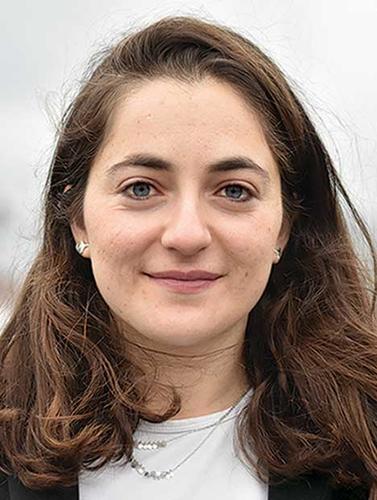
The Future of Journalism: Reporting from the Edge of the World
Where the bottom line is empathy
Sitting at the end of a fishing dock in Kodiak, Alaska, on a chilly Sunday evening in November, I caught a glimpse of a pod of orcas surfacing under the pink sky. A two-week fog had just lifted, revealing the mountains. A year ago, I was spending long hours on the C floor of Firestone Library, working on my thesis on global refugee protection and a collection of short stories. But here, on the dock, I was thinking about different tasks: I needed to call the police chief about a downtown shooting, to attend a board of education meeting, to write about an escaped herd of domesticated elk.
I could not have imagined any of that as I worked in Firestone. Then, I wished for the long months of thesis writing to be over, but what would come after — I did not know.
When graduation neared, I searched for a job that would fulfill three criteria: I wanted to make a living by writing, to make a positive and palpable difference in the world, and to be somewhere beautiful. I found myself scouring the internet for jobs that fit the bill. I sent my résumé to four daily newspaper editors in four different states. A couple of days later, I received a phone call from the editor of the Kodiak Daily Mirror.
Before I applied for the job, I would have struggled to find Kodiak on a map. The second-largest island in the United States (after the Big Island of Hawaii), Kodiak is a rainswept conglomeration of mountains that rise dramatically from the Gulf of Alaska 250 miles southwest of Anchorage. Primarily known for its brown bears — some of the largest on the planet — the island is also home to the nation’s largest Coast Guard base, a sizable commercial fishing fleet, and a rocket-launch facility. In the summer, Kodiak’s mountain peaks turn a deep emerald under nearly constant daylight. In the winter, they are blanketed with snow. The island is reachable by an hourlong plane ride from Anchorage or an eight-hour ferry from Homer. When the winds are strong, the ferry can’t dock. When the clouds are low, the plane can’t land.
When I was offered the job, I didn’t hesitate. One week after graduation, I flew from New Jersey to Alaska on a one-way ticket.
The population of Kodiak is roughly equal in size to the Princeton University student body, but any resemblance ends there. Kodiak residents are more conservative and less wealthy. Contrary to what one might expect, average winter temperatures are lower in Princeton than in Kodiak. The health of the economy is dependent on the year’s salmon harvest, which means Kodiak stands to suffer the effects of climate change in the foreseeable future. Like many other communities in America, Kodiak is battling a drug crisis. With fewer than 100 miles of paved roads, the vast majority of the island is unreachable except by boat or float plane. Aside from a single radio station and an active Facebook group, the Kodiak Daily Mirror is the only source of news on the island.
As I’m a member of a three-reporter staff (one of whom is a sports reporter), my name is on the front page of the paper five days a week. The small size of the staff means that I must be ready and willing to cover anything. When a murder trial is scheduled for the Kodiak court, I am a crime reporter. During weekly borough assembly meetings, I am a political correspondent. When a three-day conference on seaweed farming is held at the local community college, I am a mariculturalist. I have written about a remote bear-viewing lodge, flown in a six-person plane to a 100-resident Native village, and covered the impacts of state budget cuts on local artists.
Because Kodiak is a small community, the people I write about are my friends and neighbors. One morning, I interviewed a borough employee about a fuel leak near Kodiak’s single hospital, then ran into her while shopping for groceries that evening. When a friend got lost while hiking and had to be found by a search-and-rescue team, she lamented the fact that she had been hiking with the reporter who could plaster her story on the front page (I didn’t). Separating work life and personal life is virtually impossible.
The tight-knit community also means that I am a close witness to the difference I am able to make in the lives of Kodiak residents. Early last summer, Alaska Gov. Mike Dunleavy vetoed a state program that provided a monthly stipend for low-income senior citizens. I wrote a story about the 800 senior citizens in Kodiak for whom losing this funding could mean a choice between paying electric bills and keeping food on the table. Later that week, a local nonprofit began advertising a fundraiser with the goal of providing grocery gift cards for those affected by the cut. Within a day, they had raised a few thousand dollars. When I called the organizer to ask what compelled her to begin the campaign, she said it had been my article. The state program was later reinstated due to a public outcry.
On a good day, the Kodiak Daily Mirror’s front page will be seen by 5,000 people. But the limited readership does not detract from the importance of our work. The newspaper helps residents look out for one another. It reminds residents that when a law is passed on the federal or state level, in halls that lie an ocean away, it can have very real repercussions for our community. The paper is also critical for local democratic government to function effectively. The outgoing borough mayor’s typical refrain, after passing a new ordinance or making a controversial statement, was: “I can’t wait to see tomorrow’s headline.”
I first considered journalism as a career while taking a class on global reporting during my freshman year. My Princeton journalism courses took me to Greece, France, and Bosnia. A topic that came up frequently in these classes was how to make these far-off places relatable to an American audience — how to make readers care about a story unfolding half a world away. But local reporting seeks to do something else. Our stories unfold in our readers’ houses, workplaces, and schools. The bottom line of local reporting, in its best form, is empathy. There is far too little of it, and the disappearance of local reporting across America would be the dwindling of that invaluable resource.
Newspapers like the Kodiak Daily Mirror are a dying breed, and as an insider, I can see why. A copy of the newspaper costs 50 cents, which hasn’t changed in more than two decades. Even so, sales are decreasing and community members are increasingly turning to Facebook as their news source, where information may be inflammatory or biased, and is certainly not governed by any code of ethics.
I don’t know what the future of local journalism holds, but putting more brilliant minds to the task of keeping it alive might be a good start. After graduation, many of my Princeton friends dispersed to cities like New York, Washington, and London. A year ago, when I could just see graduation through a haze of thesis-writing, my peers and mentors made me think that the best professional options were in these cities. The thought of applying for a job at a small, unknown newspaper was unfathomable, and surprise is still the most common reaction to my post-Orange-Bubble career choice.
But ever since I stepped off the plane and purchased my first canister of bear spray, Kodiak has felt like home. The Kodiak Daily Mirror is a big part of that feeling. After all, it is my job to know the ins and outs of this town. Here, in this beautiful corner of the world, I am able to make a living by writing, and I watch my articles make an impact, one day at a time.








2 Responses
Barry Santana
2 Years AgoOutstanding Journalism is Alive and Well in Alaska
Iris Samuels has provided Alaska with an example what great local journalism is all about. Until I read this article, I was unaware of her contributions to the Kodiak Daily Mirror. Kodiak is a microcosm of what Alaska in general is about. She has contributed greatly to this small town on a big island in an area governed by the weather.
Iris has since moved on to the Anchorage Daily News, where she continues to provide Alaskans with informative and powerful journalism. She has become a leading reporter on state government and special projects of interest in our far north state. She continues to make a positive impact with her writing, now in Alaska’s largest city. We hope she will stay and not move on to more prestigious venues.
Marie Lenert s'58
5 Years AgoLife on Kodiak Island
Re “The Future of Journalism: Reporting from the Edge of the World”: Reading Iris Samuels ’19’s very descriptive article about Kodiak Island made me relive the two times I visited there. The author omitted reference to the daily mail — if you can’t see the mountain top, the mail will not come. I’ve read the story three times and continue to enjoy it.